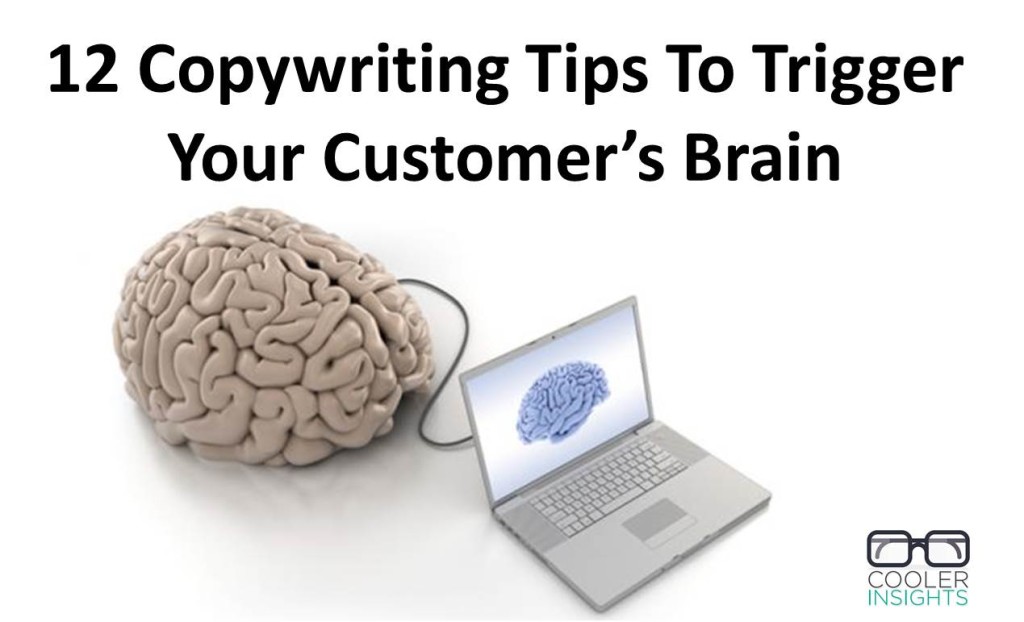Copywriting is one of the most important skills a marketer should learn.
While a picture may paint a thousand words, it is the arrangement of text on a piece of content which triggers customer action. And hopefully lead to the sale.
Thanks to the insightful book Brainfluence – 100 Ways to Persuade and Convince Consumers with Neuromarketing by Roger Dooley, this old dog learned a few new tricks about using neuroscience research in copywriting.
I found them so useful that I thought I decided to share them with you.
Grab a strong cuppa, boot up your laptop (or pen and paper), and join me in learning how you can write copy which pushes the “buy” button in your prospect’s brain.
#1 Surprise Your Audience
Our brains are intrigued by twists in the plot. And this applies to the sequence of words used in a sentence.
Neuroscientists discovered that the hippocampus – a small structure in our brain – tries to “predict” what will happen next. It does this by automatically recalling sequences of events in response to a single cue. This also occurs with the sequence of words in a sentence.
By substituting an unexpected word in a familiar phrase, you actually to jolt your reader’s brain into attention. For example, instead of writing “a stitch in time saves nine,” you could use “a stitch in time saves money.”
#2 Use a Simple Slogan
Our brains crave simplicity. At least according to neuroscience research cited by Dooley.
This is why the most memorable brands in the world like Coca-Cola, Nike or Wal-Mart employ simple slogans. Namely “Open Happiness” (Coke), “Just Do It” (Nike), and “Save Money. Live Better.” (Wal-Mart)
If you want to build your brand, use a simple slogan. Make it the centrepiece of your marketing efforts.
#3 Creatively Misuse Everyday Words
Do you know that William Shakespeare had a thing or two to teach advertising copywriters?
Apparently, the linguistic technique he used called “functional shift” can spike the brain activity of the reader. This involved using one part of a speech for another – for instance, turning a noun into a verb.
For example, a phrase like “he godded me” demonstrated this creative misuse of a word. A good modern day example of this was the word “Xerox”. This started off as a brand name which became synonymous with photocopying in the US.
Ditto for the word “Kleenex” which became a substitute term for facial tissues.
#4 A Rose by Any Other Name…
Names do matter when we try to promote different foods.
For instance, renaming a cake as a healthier sounding “muffin” actually helped to improve sales. Similarly, calling a milk shake a “smoothie” does wonders to its sales.
“Prunes” may sound old-school, but “dried plums”? That sounds just right for a new generation of health-conscious hipsters!
The lesson here is that renaming your category could help you garner new customers by shedding old stereotypes and images.
#5 Numbers Trump Percentages
In his neuroeconomics (yes, there is a “neuro” for everything) book Your Money and Your Brain, Jason Zweig revealed that the way information was framed affected how it was perceived.
Consider this. If you framed that “cancer kills 1,286 out of every 10,000 people” as opposed to “12.86 percent of people”, 32 percent more people would believe that it was riskier! Mathematically, both work out to be the same.
In short, use real numbers if you wish to magnify your benefits. Here is another example for good measure:
- Good: 83 percent of our graduates have starting salaries above $4,000 a month
- Better: 829 out of 1,000 of our graduates have starting salaries above $4,000 a month
#6 Use the Power of FREE!
This may be pretty obvious. However, it bears repeating.
Numerous studies by neuroscientists confirmed that free is a much more effective phrase than “almost free”. This applies even if the actual value of the discount exceeded the value of the free product!
Amazon’s launch of a free shipping promotion with the purchase of a second book greatly increased the value of each purchase by its customers.
Thus, while offers of a “$1” chicken rice or “20 cents” bars of soap may sound attractive, nothing beats an offer that is FREE!
#7 We love everything NEW!
Using the word “New!” isn’t anything new. In fact, it is a pretty well known strategy in copywriting.
However, do you know that making novel choices actually lights up a part of our brain called the ventral striatum?
This evolutionarily primitive part of the brain is associated with rewarding behaviour. According to neuroscientist Bianca Whittman, a shot of a “feel good hormone” like dopamine is transmitted each time we make a novel choice.
See if you can introduce a little novelty to your products. A good way to do so is to introduce a new packaging or a logo.
The trick here is to marry the trust offered by long-term brand affinity while lighting up your prospect’s brain with some novelty in your offering.
#8 Accelerate with Adjectives
Which one of these examples would make you drool?
“Ham, egg & cheese on wheat bread sandwich.”
OR
“Our Breakfast Power Sandwich starts with lean, hardwood-smoked ham and a freshly-cracked egg. Then we add Vermont white cheddar for its tangy sharpness. Finally, we grill everything on our freshly baked whole grain bread to bring out the grains’ nutty, smooth flavours.”
The choice is quite clear isn’t it?
Likewise, you should use adjectives to spice up your copy. Examples of adjective modifiers which Dooley proposed in the book are categorised as follows:
- Vivid: “Freshly-cracked” as opposed to “fresh”
- Sensory: “Hickory-smoked”, “brick oven-fired,” and “over-crisped”
- Emotional/nostalgic: “Aged Vermont cheddar” which evokes images of crusty New England dairymen
- Specific: “Wild Alaskan salmon” rather than just “fish”
- Branded: Use of brand names that are desirable. For example, having “Intel inside” or use of “Ferrari designed” casing.
#9 Empower with Stories
Our brains’ affinity for stories is hardwired. This was postulated by evolutionary psychologists to give early humans a significant advantage over other species.
Modern day neuroscientists using functional Magnetic Resonance Imaging (fMRI) machines discovered that the brains of subjects lit up in different places for different passages when they were read an exciting passage from a Hardy Boys novel (yes, that same old Hardy Boys which you love).
This was suggested as a way for our brains to turn on “scripts” based on real-world experiences.
To engage the brains (and hearts) of your prospects, try crafting a business story. Involve your customer, product or service, and include action, motion, dialogue, and other aspects of your story that will activate different parts of your prospect’s brains.
#10 Use Story Testimonials
If stories are the spark plugs of good copy, customer stories must be the petrol which lights your prospect’s fire.
For most of us, a vivid description from a friend about her personal experience visiting a restaurant works far better than the 3.5 star rating we read in an online review.
To our brain, anecdotes are more interesting and relevant than cold facts and statistics. This is why successful infomercials often include personal success stories told by the individuals themselves.
The next thing you think of getting a positive quote from your customer, flesh it out in greater detail. Include a personal anecdote with your customer’s real name, face, and story. Doing so would make your sell more convincing and memorable.
#11 Evocative Text Trumps Visuals
Citing Google’s Super Bowl commercial “Parisian Love” (see above), Dooley suggested that properly used text can beat commercials with amazing imagery, sound, and production values.
In the case of “Parisian Love”, Google simply used lots of text to tell a story. Like real Google searches, multiple suggestions were shown, as were multiple results for each completed search on the screen. Apparently, the “all text” ad worked so well that it came in fourth in a study conducted by neuromarketing company Sands Research amongst 60 or so ads aired during the 2010 Super Bowl.
The happy ending to this story? Focus on crafting a compelling plot.
(Of course, the fact that a giant brand like Google was involved may also have helped. But I digress…)
#12 Avoid Creating Negative Stories
We all know that bad customer experiences can lead to negative word of mouth.
When these complaints are spiced up by a vivid and memorable story, they could go viral in a negative fashion. This could result in an embarassing “million dollar pickle” story.
Dooley shared how a speaker at a conference narrated that a jar of pickles he bought from a supermarket had a top pickle with a large bite out of it. As the speaker had to prepare for a big Sunday cookout, he decided to return the jar to the supermarket so that they could replace it with a new one.
Unfortunately, the staff of the store gave him grief. They accused him of being the person who “took a bite out of that pickle”. They only agreed to the replacement after a lot of hassle, email exchanges and threats.
By then, the speaker vowed never to shop at the store again. He also spread the word far and wide, telling his guests about the story, his neighbours, as well as his audiences.
The same speaker calculated that the hassle over a $1.50 jar of pickles could have cost the store thousands of dollars of his family’s purchases in the following years. Cumulatively, this may even have amounted to millions should a mere fraction of the folks who heard the pickle story decide to shop elsewhere.
The moral of the story? Make sure that you speedily resolve every problem before it turns into your own “million-dollar pickle” story!


